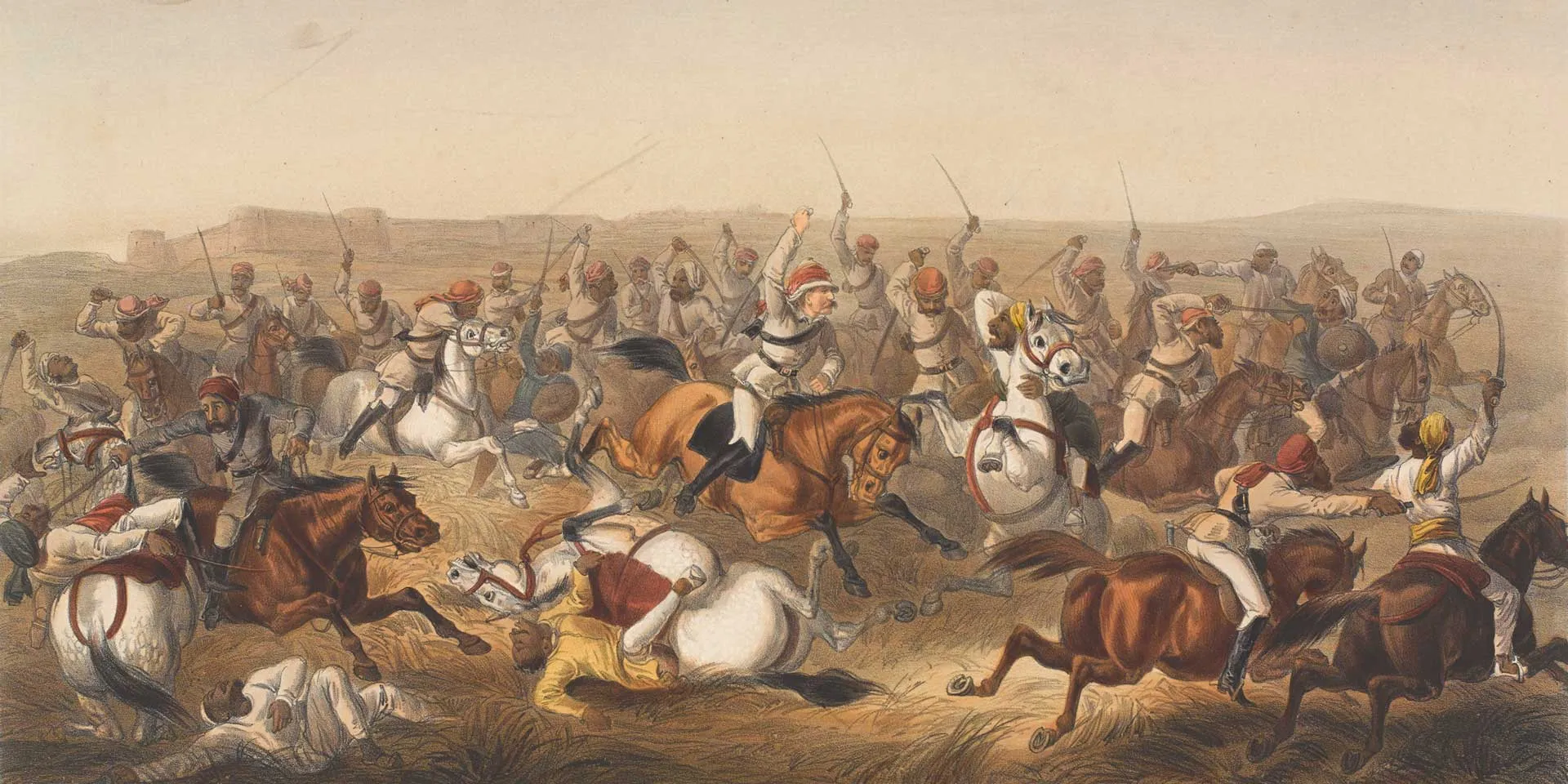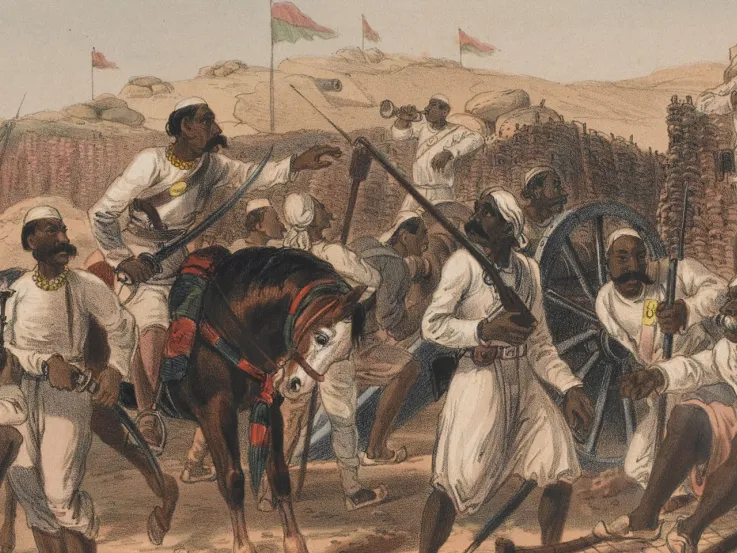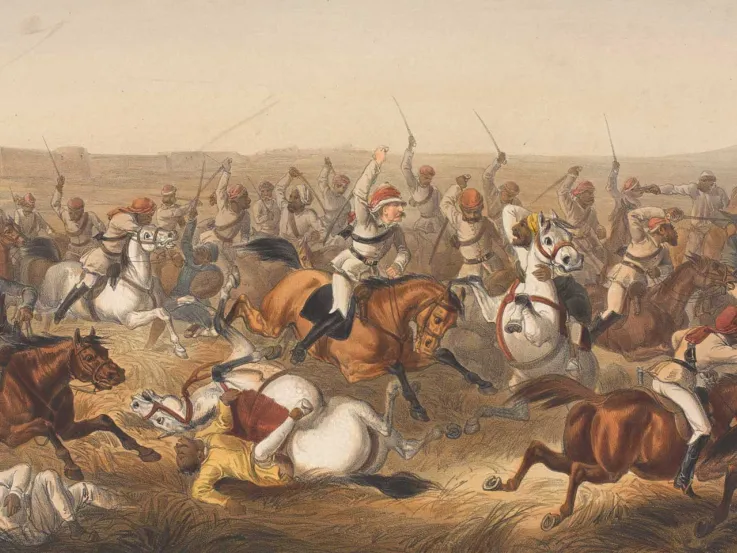Anger
Following the First Sikh War (1845-46), the British East India Company had appointed a Resident at Lahore, Sir Henry Lawrence, to control the Sikh royal court and influence policy. To this end, Lawrence exiled Maharani Jind Kaur, the mother of the child ruler Maharajah Duleep Singh, who had sought to regain some of her former influence as Regent. This act caused much resentment.
Likewise, many Sikh nobles and generals (known as sirdars) were angry at having their powers restricted as the British sought to control affairs in their regions. Some felt offended by having to obey comparatively junior British officers and administrators, most of whom were proteges of Lawrence.
Within the Khalsa (the Sikh Army), there were still many who believed they had been betrayed rather than defeated in the First Sikh War. These soldiers also resented being used to maintain order and implement policies on behalf of Lawrence and the British.
Revolt at Multan
Diwan Mulraj Chopra was governor of Multan, a Sikh city around 200 miles (320km) south-west of Lahore that had fallen under British rule after the First Sikh War. In a dispute over taxation, the British ordered that he be replaced by Sirdar Khan Singh and Lieutenant Patrick Vans Agnew, a British political agent.
However, when Agnew arrived at Multan in April 1848, he and his associate, Lieutenant William Anderson, were murdered by an angry mob. It is unlikely that Mulraj ordered their deaths, but he was forced into open rebellion because of them. Agnew's corpse was decapitated and his head returned to the British.
These murders sparked widespread rebellion and triggered the Second Sikh War (1848-49). Large numbers of Sikh soldiers deserted those regiments of the Khalsa which were nominally loyal to the British-controlled royal court. They soon joined Mulraj and the rebellious sirdars.
Local initiative
At the time of the Multan revolt, the British had few troops in the Punjab. They had even reduced the size of the Bengal Army after the First Sikh War in order to cut costs. So there was a shortage of available men.
Keen to prevent rebellion spreading rapidly to the whole of the region, and having no senior officer to consult, Lieutenant Herbert Edwardes, the political officer in Bannu, took the initiative. He raised a body of Pathan irregulars and on 18 June 1848, along with a force of loyal Sikh troops, defeated an army of Mulraj’s supporters at Kineyri.
On 3 July, with reinforcements from his neighbouring political officer Lieutenant Edward Lake, and with troops sent by the Nawab of Bahawalpur from south of Multan, he defeated the rebels again at Sadusam, forcing them to retreat to Multan fort.
Meanwhile, the Governor General of India, Lord Dalhousie, and General Sir Hugh Gough, Commander-in-Chief India, were organising their troops for a major campaign in the Punjab. However, they decided to delay this until November 1848, when the the hot weather and monsoon seasons would be over. Until then, the troops available in the Punjab would have to act alone.
Siege of Multan
In August, a hastily-gathered British force, under General William Whish, marched to join Edwardes at Multan. Whish’s force included supposedly reliable troops from the Khalsa, led by Sher Singh Attariwalla. But these rebelled in September, forcing Whish and Edwardes to raise the siege.
Sher Singh then marched his men several miles north and began fortifying the crossings on the River Chenab in preparation for a possible British attack.
In November, Gough and Dalhousie’s reinforcements started to arrive along with new supplies, some coming by sea and river transport up the rivers Indus and Chenab. This included 150 artillery pieces, some of which were heavy siege guns. Besieging Multan once again, Whish used these to blast breaches in the walls.
On 27 December, the British attacked. Multan was finally secured by 22 January 1849 after weeks of heavy fighting. Mulraj surrendered following negotiations directed by Edwardes. He was spared execution, but sentenced to life imprisonment.
Afterwards, Whish marched his army north, later linking up with Gough for the decisive Battle of Gujerat in February.
Ramnagar
Just as Whish’s siege of Multan was re-commencing, another battle was being fought at Ramnagar on the River Chenab on 22 November 1848. The British troops were led by Gough, who had finally advanced into the Punjab. The Sikhs were commanded by Sirdar Sher Singh, whose troops had established strong positions on both sides of the main river crossing.
At dawn, Gough ordered a force of cavalry and horse artillery, with a single infantry brigade, straight into the attack. Although the river was fairly narrow, the wide bed it occupied during the monsoon season consisted of soft sand.
The 3rd Light Dragoons and 8th Bengal Light Cavalry drove some of the Sikhs back across the river from their positions on the east bank. But they then came under heavy fire from cleverly concealed artillery, and struggled to withdraw through the soft ground.
The Sikh cavalry then advanced across the river to attack them. Gough ordered the 14th Light Dragoons and the 5th Bengal Light Cavalry to counter-attack. After driving back the Sikh horsemen, they too were raked with artillery fire, sustaining heavy losses before a general retreat was sounded.
Morale
Although forced to withdraw from the eastern bank of the Chenab, the Sikhs regarded Ramnagar as a victory, which boosted their morale.
Gough forced his way across the river a few weeks later and outflanked the Sikhs defending the fords, but he then paused to await further infantry reinforcements. The Sikhs were then able to withdraw in good order. Dalhousie also ordered Gough to halt operations while waiting for Multan to fall.
Frontier areas
On the outbreak of unrest, the Afghans and several tribal leaders in the Sikh-controlled North West Frontier, also took up arms against the British. Several fought with Chattar Singh Attariwalla, the Sirdar of Peshawar, and Sher Singh’s father. The Afghans hoped to regain their old province of Peshawar in return for aiding the rebel Sikhs.
In June 1848, Captain John Nicholson, commanding locally raised Muslim irregular cavalry, seized the vital fort of Attock on the River Indus from its Sikh garrison, while they were still unprepared. Nicholson then linked up with Lieutenant James Abbott's local Hazara levies to capture the passes in the Margalla Hills which separated Hazara from the Punjab to the south. This temporarily kept many of Chattar Singh’s troops bottled up in Hazara.
Nevertheless, enough Afghans eventually joined the fray to convince the Muslim troops installed by Nicholson at Attock to change sides. This allowed Chattar Singh to move out of Hazara and march west and then south in order to join with Sher Singh's army in the central Punjab.
Chillianwala
Learning of the fall of Attock, Dalhousie now ordered Gough to defeat Sher Singh before Chattar Singh’s troops could join him and strengthen his force. Gough met Sher Singh on 13 January 1849 near the village of Chillianwala, located on the River Jhelum and around 90 miles (145km) north-west of Lahore.
Gough’s men launched a frontal attack on the Sikh positions, advancing through thick scrub that hid the Khalsa’s artillery. Outstripping their accompanying battalions of native infantry, the 24th (2nd Warwickshire) Regiment arrived upon the enemy prematurely. Under instructions not to fire, they fixed bayonets and charged the artillery crews.
In this gallant but foolhardy attack, the regiment suffered 515 casualties, including 238 killed. 'Their conduct,' wrote General Sir Charles Napier, 'has never been surpassed by British soldiers on a field of battle.'
However, the actions of the elderly and infirm Lieutenant-Colonel Alexander Pope, commanding the 2nd Cavalry Brigade, merited less praise. After difficulties in organising his cavalry to face the right direction, Pope gave an indistinct instruction, which was interpreted as ordering a retreat. Luckily, the brigade's flight was halted just in time by an army chaplain.
'Our loss has been severe, and the mismanagement very disgraceful, yet it will be called a victory and lauded accordingly... [The senior officers] are not able to stand the wear and tear of Indian service. They become still more worn in mind than in body. All elasticity is gone; all energy and enterprise worn out; they become, after a fortnight's campaign, a burden to themselves, an annoyance to those under them, and a terror to everyone but the enemy.'Lieutenant William Hodson — January 1848
Victory?
The Sikh army failed to drive home its initial advantage. After bitter fighting, the British infantry broke the back of the Sikhs' defence and drove them from their trenches. But Gough then ordered his infantry to halt and fall back on the village of Chillianwala.
The Sikhs withdrew under cover of darkness, taking with them three captured British colours. But a large force returned during the night to reclaim 28 of the 40 guns the infantry had fought so hard to take. The Sikhs also killed many of the British wounded who had been left on the battlefield.
Gough claimed the battle as a victory, despite the fact that Sher Singh was still able to march northwards to join Chattar Singh. Gough’s reputation was also sullied by his clumsy tactics, which resulted in 2,300 British casualties, for which he received much criticism.
Sikh gamble
The combined Sikh forces, under Sher Singh and Chattar Singh, was soon running low on supplies, so it now attempted a daring outflanking move against Gough. After moving east, intending to cross the Chenab, it then moved south before crossing the river again to attack Gough from the rear.
When they reached the river, they found it swollen by heavy rains. The few crossable fords were defended by irregular Muslim cavalry led by Lieutenants Harry Lumsden and William Hodson, who were also, like Edwardes and Nicholson, proteges of Sir Henry Lawrence.
Thus thwarted, the Sikhs withdrew to Gujerat, about 75 miles (120km) north of Lahore, where they quickly prepared an entrenched defensive position.
Gujerat
The decisive action of the war was fought at Gujerat on 21 February 1849. Gough had assembled an army of some 24,000 men, including General Whish’s troops fresh from victory at Multan and, importantly, their heavy guns. Gough attacked a Sikh force estimated to be at least 60,000-strong.
After an artillery duel lasting some two and a half hours, many of the Sikh batteries were knocked out. Their hastily erected screens of brush wood were not as effective as the scrubland and jungle which had hidden their artillery from British view at Chillianwala.
With the enemy firepower reduced, Gough ordered his infantry forward in a general advance. Although Sikh resistance was fierce, they were eventually forced to give ground, and the retreat soon became a rout. This was followed up by the horse artillery and cavalry.
On 14 March, the remnants of the Sikh army surrendered at Rawalpindi. Following the Sikhs’ decisive defeat, their remaining Afghan and frontier tribe allies retreated from the Punjab, Peshawar and Attock fort.
Aftermath
Maharaja Duleep Singh was deposed and his mother, the Regent, was replaced by a new Council of Regency under the direction of the British Resident in Lahore, Sir Henry Lawrence. The Punjab and the North-West Frontier were both annexed by the British Empire on 29 March 1849.
The British government became the guardian of the young Maharaja, who eventually went into exile in Britain in 1854. He made two brief visits to India. But when he attempted to return there again in 1886, he was intercepted at Aden and forced to return to Europe. He died in Paris in 1893.
Chattar Singh and Sher Singh were initially placed under surveillance, but later imprisoned at Allahabad. They were released from confinement in 1854 and permanently exiled from the Punjab. Chattar Singh died in Calcutta in 1855. His son passed away three years later at Benares.
The Punjab Medal was awarded to the officers and men of the British Army and Bengal Army who served in the Punjab between 7 September 1848 and 14 March 1849.
Although the British had emerged victorious, the enormous casualties inflicted on their better-equipped forces in battles like Chillianwala undermined their aura of invincibility.
The two Sikh conflicts served to weaken British prestige, which had already been knocked by the setbacks of the First Afghan War (1839-42). And this no doubt emboldened some of those who rose up against British rule during the Indian Mutiny (1857-59).
Recruitment
Following the annexation of the Punjab, the British began to recruit Sikhs into their military, impressed by the fighting qualities the Khalsa had displayed. The Sikhs were designated a ‘martial race’ and went on to provide a disproportionate number of recruits to the East India Company’s forces, and later the Indian Army.
The newly recruited Sikhs played a major role in safeguarding British rule during the suppression of the 1857 rising. Somewhat ironically, they fought against many of the high caste Hindu sepoys of the Bengal Army who had served on the British side in the Sikh Wars.
One of main factors in making those sepoys rebel in 1857 was the extension of British recruitment to Sikhs, Muslims and lower caste Hindus from the late 1840s onwards, as this was seen as a threat to their traditional social status.



























